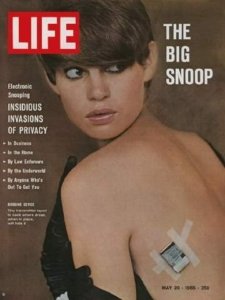In case you hadn’t noticed, there’s quite a long history of privacy concerns in the US. We certainly have plenty of privacy issues to worry about nowadays with all the technology surrounding us that we literally have no idea how it works or, really, what it’s doing. Even the people who run them sometimes don’t seem to know exactly what their tech is doing or how it works.
There are certainly very valid fears when it comes to the powerful technologies we create; guiding how we, as a society, use them can be challenging. But as history also shows, often much of the concern turns out to be simple fearmongering. When some new but confounding technology enters the scene, there’s buzz, there’s worry, and narratives are created to tell the story of how this technology or that might be dangerous. Sometimes the fears are true, sometimes they’re not. Let’s take a walk through the past and look at the history of privacy concerns that have come before.
What’s a techno-panic?
 With almost every new technology, there is an initial resistance to change that society has to overcome before they’re able to accept a world with different and never-before-seen tools. From the written word causing people to fear memory loss in oral societies, to the printing press scaring people about mass dissemination of dangerous ideas, new technology requires an assimilation time. And often, in the course of accepting how the world will be different with a new technology, society tends to go through a techno-panic.
With almost every new technology, there is an initial resistance to change that society has to overcome before they’re able to accept a world with different and never-before-seen tools. From the written word causing people to fear memory loss in oral societies, to the printing press scaring people about mass dissemination of dangerous ideas, new technology requires an assimilation time. And often, in the course of accepting how the world will be different with a new technology, society tends to go through a techno-panic.
Techno-panic is the phenomenon of fearmongering and creating a moral outcry in objection to a new innovation. It’s understandable, but it’s not always justified in the long run. Especially when advancement and progress is only made through innovation.
Privacy in the mail (1782)
 Back in the early days of the US, mail was one of the only ways to communicate over long distances. There was a problem, however. Mail carriers were liable to read sensitive information if they had the gall to open your mail. It wasn’t only the mail carriers either — letters could be intercepted!
Back in the early days of the US, mail was one of the only ways to communicate over long distances. There was a problem, however. Mail carriers were liable to read sensitive information if they had the gall to open your mail. It wasn’t only the mail carriers either — letters could be intercepted!
If you were writing to your sister about this spring’s tulip blossoms, you may not have been as concerned about fearmongering around mail privacy. But people with important communications at stake were. It makes sense that, “Thomas Jefferson, Alexander Hamilton, and George Washington frequently complained about the lack of privacy in their letters, and they would sometimes write in code.”
The narrative that mail was not private and any information contained in an important letter was a security risk created a milestone in the history of privacy concerns that has never fully gone away. After all, didn’t your mother ever tell you not to send cash in the mail?
Kodak (1888)
 If you’ve ever seen someone holding their phone at a conspicuous angle as you do something embarrassing, you know the feeling that society went through at the invention of the Kodak camera. The narrative as the camera exploded in popularity became one of fear that your most embarrassing moment could be caught and shared. In fact, part of the fearmongering was that, “the sedate citizen can’t indulge in any hilariousness without the risk of being caught in the act and having his photograph passed around among his Sunday School children.”
If you’ve ever seen someone holding their phone at a conspicuous angle as you do something embarrassing, you know the feeling that society went through at the invention of the Kodak camera. The narrative as the camera exploded in popularity became one of fear that your most embarrassing moment could be caught and shared. In fact, part of the fearmongering was that, “the sedate citizen can’t indulge in any hilariousness without the risk of being caught in the act and having his photograph passed around among his Sunday School children.”
Just imagine a world where anywhere you go, at any given moment, someone could take a photo of you! It sounds like a silly thing to be frightened of, doesn’t it? Thankfully for society, we’ve moved past these ridiculous fears into a bright and optimistic future where we’re afraid that someone may not catch our every hilariousness on camera, making us go viral. If a self-indulgent dance happens in the woods but no one posts it on TikTok, did it really happen? Oh, the panic!
Transistors (1950s)
 Soon came a new narrative to plague Americans in the history of privacy concerns. This was a fear of transistors. While it’s true that this small piece of tech is a key innovation of the history of the modern microchip, they were also a fount of reliable fearmongering for a couple of decades because they also brought about bugs as secret listening devices.
Soon came a new narrative to plague Americans in the history of privacy concerns. This was a fear of transistors. While it’s true that this small piece of tech is a key innovation of the history of the modern microchip, they were also a fount of reliable fearmongering for a couple of decades because they also brought about bugs as secret listening devices.
In an age of James Bond spying, organized crime, and whispering secrets to your girlfriend on the phone late on a Saturday night, a bug that was secretly listening to you was ripe for creating a techno-panic. Nevermind the fact that today we have both surveillance capitalism and the even more ominous surveillance state, bugs were a big deal in the early days of transistors.
RFID (2000s)
 By the 2000s, society had plenty of fearmongering to go around about a host of technologies. From video games, to browser cookies, to getting catfished, techno-panics were plentiful. One specific narrative that had many people in a tizzy was the use of RFID (Radio Frequency Identification). These chips can communicate data over a short distance. Retailers started using them to track products on their supply chains. The narrative around RFID chips was that they could be placed on people or around certain locations and gather data without people knowing or consenting.
By the 2000s, society had plenty of fearmongering to go around about a host of technologies. From video games, to browser cookies, to getting catfished, techno-panics were plentiful. One specific narrative that had many people in a tizzy was the use of RFID (Radio Frequency Identification). These chips can communicate data over a short distance. Retailers started using them to track products on their supply chains. The narrative around RFID chips was that they could be placed on people or around certain locations and gather data without people knowing or consenting.
Today, many people have key fobs that use RFID technology, and they don’t think twice about it. Most people also willingly use NFC (near-field communication) on their phones or smart watches to make payments for purchases which can be (and are) all traceable.
Crypto (2010s)
 When Bitcoin was first created and started gaining popularity, there was definitely a techno-panic about it. In some circles, that narrative is still going on. The fear and skepticism toward crypto has many sides to it, but privacy is certainly one of them. Despite being pseudonymous, the transparency of blockchains can also be a little terrifying when every transaction is publicly available.
When Bitcoin was first created and started gaining popularity, there was definitely a techno-panic about it. In some circles, that narrative is still going on. The fear and skepticism toward crypto has many sides to it, but privacy is certainly one of them. Despite being pseudonymous, the transparency of blockchains can also be a little terrifying when every transaction is publicly available.
If someone is inclined to do a bit of after-dinner fearmongering, they can probably find a willing audience to whip into a state of panic with a narrative that says crypto is not only used by criminals, but it can also be used by governments to track your every move. Yes, even governments can look at blockchain transactions. But if that freaks you out, don’t even think about CBDCs!
Like other technologies that came before, however, crypto is not just the narrative that surrounds it. In fact, it’s one of the only technologies today that is trying to innovate for the specific purpose of turning a page on the history of privacy concerns in this country and securing true personal data ownership.
Privacy fears today
 There are other narratives still being told today about how new technology can threaten privacy and security. Techno-panics around self-driving cars generate fearmongering for many reasons like jobs being lost, safety on the roads, along with data collection privacy.
There are other narratives still being told today about how new technology can threaten privacy and security. Techno-panics around self-driving cars generate fearmongering for many reasons like jobs being lost, safety on the roads, along with data collection privacy.
We’re also scared of big data as the algorithm scrapes up every last bit of information about us and uses it to profit giant corporations and governments who don’t even tell us they’re doing it, let alone compensate us for using our data. But looking at the entire history of privacy concerns in the US, it’s obvious that any new technology will create some level of fear. The question of how real those fears are can only be answered with time and by intentionally embracing innovations that hold privacy, security, and decentralization as the highest values.
What we can learn from the history of privacy concerns
The world of crypto may not be perfect today. It may never be perfect. But it’s certainly one of the only technology spaces that’s pulling out all the stops to prioritize privacy and counterbalance some of the justified fears that people have when it comes to their personal information. We mostly trust the mail today, but people were not crazy to question security in the past. There are cameras on everyone’s person at all times nowadays, but that brings both benefits and dangers. With every technology there are real risks, but there are also unnecessary panics. Distinguishing the difference can only be done when you educate yourself and release fear in favor of solutions.
About the Author

Michael Hearne
About Decentral Publishing
Decentral Publishing is dedicated to producing content through our blog, eBooks, and docu-series to help our readers deepen their knowledge of cryptocurrency and related topics. Do you have a fresh perspective or any other topics worth discussing? Keep the conversation going with us online at: Facebook, Twitter, Instagram, and LinkedIn.


